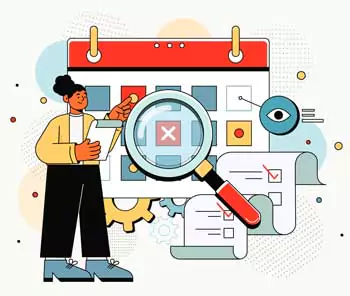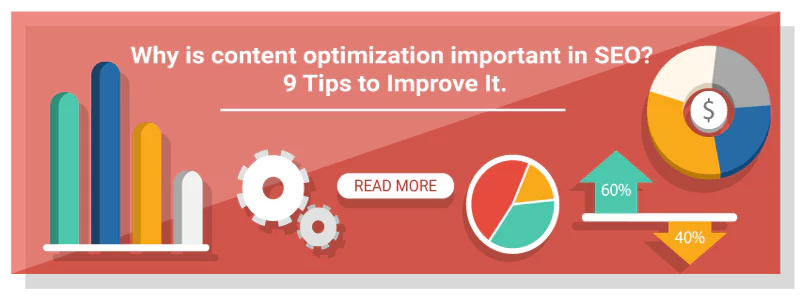Contents
- 1 How Content Optimization Works?
- 2 Types of Content Optimization
- 3 On-Page Content Optimization
- 4 Off-Page Content Optimization
- 5 Technical Content Optimization
- 6 User Experience (UX) Optimization
- 7 Social Media Optimization
- 8 Content Optimization Best Practices
- 9 9 Tips and Techniques on How to Optimize Content
- 10 Summary
- 11 FAQs About Content Optimization
Imagine having a treasure trove of valuable content, but it’s buried under a pile of rubble, inaccessible and unseen by anyone. Content optimization is the key that unlocks this treasure, making your content not only visible but also valuable to those who need it the most. It’s the process that transforms ordinary content into a shining beacon that attracts, engages, and converts your audience. Let’s dive into the world of content optimization and explore its types and importance in detail.
Understanding the Content Optimization
Content optimization in SEO is the process of making your content as effective as possible in achieving its intended purpose. This means ensuring that it is discoverable, engaging, and actionable. Whether you’re writing blog posts, creating videos, or developing social media content, optimizing it ensures that your target audience can easily find and engage with it.
How Content Optimization Works?
It involves using various strategies and techniques to improve the visibility and effectiveness of your content. This includes optimizing keywords, enhancing readability, improving site speed, and ensuring mobile-friendliness.
Key Components of Content Optimization
The main components include on-page optimization, off-page optimization, technical optimization, user experience (UX) optimization, and social media optimization. Each plays a crucial role in making your content stand out in the crowded digital landscape.

Types of Content Optimization
- On-Page Content Optimization
- Off-Page Content Optimization
- Technical Content Optimization
- User Experience (UX) Optimization
- Social Media Optimization
- Content Optimization Best Practices
On-Page Content Optimization
Importance of On-Page Optimization: On-Page Optimization refers to the strategies and techniques applied directly on your website to enhance its visibility and ranking in search engine results. It’s all about making your content relevant and valuable to both users and search engines.
Elements of On-Page Optimization
Keyword Research: Identifying the right keywords that your audience is searching for.
Content Creation: Crafting high-quality, informative, and engaging content that incorporates these keywords naturally.
Meta Tags Optimization: Optimizing title tags, meta descriptions, and headers to improve search engine visibility.
Internal Linking: Creating links within your site to help search engines understand the structure and hierarchy of your content.
Off-Page Content Optimization
Importance of Off-Page Optimization: Off-Page Optimization involves activities conducted outside your website to improve its authority and reputation. This helps in gaining higher rankings in search engine results.
Techniques of Off-Page Optimization
Link Building: Acquiring high-quality backlinks from reputable websites.
Social Media Sharing: Promoting your content on social media platforms to increase visibility and engagement.
Guest Blogging: Writing articles for other websites to gain exposure and backlinks.
Influencer Outreach: Partnering with influencers to amplify your content’s reach and credibility.
Technical Content Optimization
Importance of Technical Optimization: Technical Optimization focuses on the technical aspects of your website that affect its performance and visibility. This ensures that your content is easily accessible and understandable by search engines.
Key Elements of Technical Optimization:
Site Speed Optimization: Ensuring your website loads quickly to enhance user experience and search engine rankings.
Mobile-Friendliness: Making sure your content is accessible and readable on mobile devices.
Structured Data: Implementing schema markup to help search engines understand your content better.
HTTPS Security: Securing your website with HTTPS to build trust with users and search engines.

User Experience (UX) Optimization
Importance of UX Optimization: User Experience Optimization focuses on making your content enjoyable and easy to navigate for users. A positive user experience leads to higher engagement and conversion rates.
Strategies for UX Optimization:
Page Layout: Designing an intuitive and aesthetically pleasing layout.
Readability: Using clear, concise language and formatting for easy reading.
Navigation: Ensuring easy and logical navigation throughout your site.
Engagement Metrics: Monitoring metrics like bounce rate, session duration, and conversion rates to assess and improve user experience.
Social Media Optimization
Importance of Social Media Optimization: Social Media Optimization involves enhancing your content’s visibility and engagement on social media platforms. It helps in reaching a wider audience and driving traffic to your site.
Best Practices for Social Media Optimization
Profile Optimization: Creating complete and appealing social media profiles.
Content Sharing: Regularly sharing valuable content to engage your audience.
Engaging with the Audience: Interacting with followers to build a community and foster loyalty.
Analytics and Monitoring: Using analytics tools to track performance and optimize strategies.
Content Optimization Best Practices
To succeed in content optimization, it’s crucial to keep your content updated, prioritize quality over quantity, regularly analyze performance, and stay informed about the latest trends and algorithms.
Understanding E-E-A-T
E-E-A-T—Experience, Expertise, Authoritativeness, and Trustworthiness—is an acronym that Google introduced to guide its Search Quality Evaluator Guidelines (SQEG). While it’s not a direct ranking factor, it plays a pivotal role in shaping how search results are evaluated.
- Experience (E):
- Experience refers to the depth and breadth of knowledge a content creator possesses.
- Google values content that reflects real-world experience. Whether it’s medical advice, financial guidance, or travel tips, expertise gained through practical application matters.
- Expertise (E):
- Expertise goes beyond mere familiarity. It’s about being a recognized authority in a specific field.
- Google assesses whether the content creator has the credentials, qualifications, or demonstrable expertise to speak authoritatively on a topic.
- Authoritativeness (A):
- Authoritativeness relates to the reputation of the content creator or the website.
- High-quality backlinks, positive reviews, and mentions from reputable sources contribute to authoritativeness.
- Trustworthiness (T):
- Trustworthiness is critical. Users should feel confident that the information they find is reliable and accurate.
- Transparency, clear sourcing, and avoiding deceptive practices all contribute to building trust.
Why E-E-A-T Matters:
- E-E-A-T helps Google’s Quality Raters evaluate content quality. These human evaluators follow guidelines to assess whether search results meet user needs.
- While E-E-A-T isn’t a direct ranking signal, adhering to its principles can enhance your content’s visibility.
- Website owners should strive to align with Google’s definitions of quality and relevance by incorporating E-A-T principles into their publishing practices.
Remember, E-E-A-T isn’t just about algorithms; it’s about creating content that genuinely serves users and builds trust. So, let your expertise shine, be authoritative, and foster trust—it’s a winning formula!
Common Content Optimization Mistakes to Avoid
Avoid keyword stuffing, neglecting mobile optimization, ignoring user intent, and producing low-quality content. These mistakes can harm your rankings and user engagement.
The Future of Content Optimization
The future of content optimization is exciting, with advancements in voice search, AI, and video content. Staying ahead of these trends will ensure your content remains effective and relevant.
9 Tips and Techniques on How to Optimize Content
As complicated as it may seem at first, optimizing content is actually a logical and methodological process. Here are 9 essential tips for how to do content optimization and get top rankings on search engine results pages:
1. Write great content: Great content follows the E-E-A-T principle, as stipulated by Google. Content that is based on expertise, experience, authoritativeness, and trustworthiness will rank better than content that is simply a reworked mish-mash of other people’s ideas. Since you know your business better than anyone, writing content that describes your niche, your audience’s pain points, and your own original perspectives should be right up your alley.
2. Keep new content coming:Another tip for optimizing your content is to post new content regularly. Search engines love fresh, original, and updated content, and your readers will too.
3. Use headings:Optimized content is divided into logical and progressive sections, so the text is readable and digestible. Search engines love headings, and it is important to create a hierarchical structure for the article, with H1, H2, and H3 headings that are clearly defined. Another tip: use keywords within the headings, which will kill two birds with one stone.
4. Optimize the text:You can optimize existing text simply by adding a few key content optimization devices. Title tags, Meta descriptions, meta keywords, and URLs are all great ways to get your content noticed by search engines.
5. Optimize images: People online spend as much time searching for images as they do text. As such, make sure you’re up to speed by optimizing all images within your content. Add alt tags, which serve as alternate text; use image tags, which are the words that show up when a user scrolls over an image; and make sure the file size of your images has been adjusted properly to ensure that all images load and view properly.
6. Optimize videos:Like images, great headings, and other graphics or bold colors, videos grab the readers’ attention and help keep them hooked. If you don’t have your own videos to upload, you can use websites such as YouTube to find great clips that can be embedded into your site. As always, use good keywords in your video titles, descriptions, and tags; share videos on social media sites; and use a video as a call to action or another way to drive sales.
7. Stop writing for search engines:Search engines are only getting smarter and more adept at weeding out poor-quality content. Your content should be created with the audience in mind – the real people you are targeting in the hope they will consume your content. Instead of focusing exclusively on keywords, over-linking, or creating content that’s low quality just for the purpose of publishing, relax, take a deep breath, and back off from over-optimizing. Focusing on content that is natural sounding and useful will get you a long way, and then optimizing after that by doing the things mentioned above is key.
8. Use social media:Social media is very important when it comes to content optimization, and simply posting a link isn’t enough. Rather, build relationships with relevant users and connections through social media sites, share other users’ content, provide feedback, and use your social media site for more than just posting. This added engagement increases the authority of your page and will help it get higher rankings.
9. Keep it clean: Finally, know that a search engine won’t rank content that it can’t easily find. As such, make sure you keep your code clean and organized, and your site secure, which helps search engines find your content efficiently. Additionally, know that publishing content that is already copyrighted or produced by ChatGPT with no human touch will tend to rank poorly. For best results, use your own original talent to create unique content and avoid raising any red flags.
Summary
In today’s digital age, content optimization is not just an option but a necessity. By understanding its types and implementing best practices, you can ensure that your content not only reaches but also resonates with your target audience. Keep optimizing, stay updated, and watch your content thrive.
FAQs About Content Optimization
What is the main purpose of content optimization?
The main purpose of content optimization is to enhance the visibility, engagement, and effectiveness of your content in achieving its intended goals.
How long does it take to see results from content optimization?
Results can vary, but generally, it takes a few months to see significant improvements in rankings and engagement.
Can I optimize content on my own?
Yes, with the right knowledge and tools, you can optimize content on your own. However, professional help can provide advanced strategies and faster results.
How often should I update my content optimization strategy?
Regular updates are crucial. It’s recommended to review and update your content optimization strategy at least every quarter to stay aligned with the latest trends and algorithms.


Trackbacks/Pingbacks